
Mar 31, 2001, The B. H. Manuscript/Collectible/Philatelic Sale, Sale 9

Lot 843
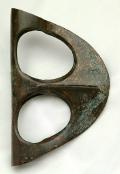

Ancient Bronze Axe
Head. Mesopotamia or Western Iran, 2nd millennium BC. This fenestrated
axe head in bronze is shaped in a crescentic form with integral sockets.
There is a reinforcing ridge at the center of the blade between the two
openings, thereby making this blade a relation to the so-called "duck bill"
axe heads of western Asia Minor and Palestine. Length: 4-3/4".
Cleaned in the past, and now with pleasant brown and red patina with some
touches of green. Blade in choice condition.
The lightweight
construction of this blade is of particular interest. As it is not nearly
substantial enough for regular military use, the piece would have been
employed in a ceremonial or cultic fashion.
Estimated Value $350-450.
Lot 844
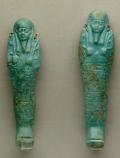

Ancient Egyptian
Ushabtis. XXIX-XXX Dynasties, circa early 4th century BC. A framed
display of two, medium-size Late Dynastic ushabtis of different
individuals, custom mounted in plexiglas shadow box, and rest upon a linen
background. Both of related style, and so close together in date. The
smaller illustrates somewhat more robust features, while the larger piece
is more idealized. Both draped in form fitting Osirid wrappings, each
wearing lappet headdresses, and false beards. Each holds in their crossed
arms a hoe and an adze. The lower front of each with seven lines of
hieroglyphs. Both molded in faience, with light blue-green glazes.
Measuring 6-1/2" and 7", respectively. Frame size: 12-1/2 x 11-1/2".
Both nicely preserved with modest surface deposits or minor surface
flaking. Overall a very pleasing pair.
Estimated Value $900-1,200.
Lot 845


Ancient Indian Copper
Harpoon Head. Ancient India. Upper Ganges Region, perhaps Uttar
Pradesh, circa 1500 - 1300 BC. An impressive, wicked-looking implement. On
a thick rounded shaft, the triangular blade features a substantial
reinforcing midrib plus barbed ends at the base of the blade. Further back
are two additional pairs of barbs and two projections for hafting.
Length: 14". The shaft is pierced to hold a cord. Some chipping or
wear to edge of blade, and at two of the barbs. Tool with dark green and
brown patina.
The harpoons of this type are undoubtedly the most
exotic weapons of Bronze Age India. Examples have been found in virtually
pristine condition, and so their use remains conjectural -- were they used
for hunting of big game in the Ganges, or were they just ceremonial or
status symbols? Regardless, the blades are associated with evidence of the
first sedentary settlements in Northern India.
Estimated Value
$2,000-3,000.
Lot 846


Ancient Judean Bronze
Incense Shovel. Roman Judaea, circa 1st-2nd century AD. Well crafted
sacrificial implement with five feet, four under blade and one at end of
handle, to keep it raised for easy use. The shovel's blade is box-like and
shallow with walls on three sides. The long handle of octagonal section
with large ring-shaped finial. The piece is intact and well preserved with
moderately heavy green patina. Length: 10-1/2". The absence of any
cultic symbols suggest this artifact may have been employed by non-Romans,
i.e. Jews. Said to have been found near Tiberius. A handsome object from
ancient Judaea. Scarce.
Estimated Value $800-1,000.
Lot 847
Ancient Palestinian
Seals. Circa 18th-9th century BC. Antiquites include: 3 seals, a
cylinder, and a small Egyptian ushabti. The earliest seal is a Hyksos
scarab, carved in steatite, with lovely scroll pattern on base. The other
two are Early Iron Age, Syro-Palestine, with animal motifs. One is a scarab
in brown-black serpentine, the other a once-glazed scaraboid in frit. Also
in frit, a once glazed Neo-Assyrian cylinder with contest scene: lion
attacking man-headed bird or griffin. Last a Late Dynastic miniature
ushabti in green-glazed faience -- the features blocky, but glaze choicely
preserved. Lot of 5 pieces. The scarab chipped, the other seals with
varying degrees of wear. An interesting little group. Seals average 16 mm.;
the ushabti, 57 mm.
Estimated Value $200-275.
Lot 848


Ancient Roman Bronze
Adze Head. Roman Empire, circa 1st-2nd century AD. An unusually
attractive specimen, the head has an offset oval socket and waisted blade
(the sides concave). The edge of the blade is curved with modest ancient
chipping, probably from use. Blade features a similar patina to previous
and following lot, and likely from same find area. Quite artistic in
appearance for such a utilitarian item. Length: 6". Choice and
scarce.
Estimated Value $750-950.
Lot 849


Ancient Roman Bronze
Mallet Head. Roman empire, circa 1st-2nd century AD. Substantial mallet
head of faintly crescentic shape with squared ends and of rectangular
section with beveled corners. Overall finely preserved, with pleasant deep
earthen to emerald green patina. Length: 6 ¼". As judged by
the patina, likely of Roman European origin, probably Germany or Bulgaria.
Ends are somewhat flared from use. Scarce in this quality.
Estimated
Value $750-950.
Lot 850


Ancient Roman Bronze
Pickaxe Head. Roman Empire, circa 1st-2nd century AD. With an elongated
rhombe shape, this large and robust head flares up in size towards the
blades -- making it rather boatlike in appearance. One blade is vertical
and rounded, the other, oblique and straight. Roman Europe, probably found
Germany or Bulgaria. Head exceptionally well preserved, with smooth deep
green patina. Length: 10 ½". Rare this nice.
Estimated
Value $800-1,000.
Lot 851


Bronze Oil Lamp.
Iran or northern India, circa 18th - early 19th century AD. Elaborate
bronze lamp in the form of a bird, possibly a parrot, standing on a
circular base. The bird's body serves as the lamp's oil receptacle with a
vent hole at its stomach. The lamp, upon which the bird stands, is a small
circular body and long narrow spout. The bird is crafted with nicely
fashioned details. Height: 4-1/2"; Length: 7-1/2". A handsome
example of this popular collectible.
Estimated Value $300-400.
Lot 852
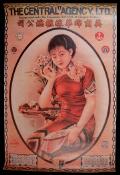

Chinese Vintage Product
Posters. Here we offer seven vintage Chinese product posters, circa
1930. Each is presented in vibrant color, featuring attractive Asian models
that promote a variety of objects including fabric, thread, soap, and gin.
One piece is actually a calendar. Each measures roughly 30 x 21", with
protective metal strips along upper and lower edges. One duplicate. Metal
strips have rusted, most have light wear at edges, and minor abrasions. Top
edge is torn on one poster. Conditions range from fair to very good.
Estimated Value $250-UP.
Lot 853
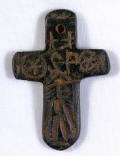

Crusader's Cross.
Acre, Syria, circa 10th - 12th century. Rich, black obsidian stone
cross, hand-cut and incised with early Christian symbols on both sides.
Found in the seaport city of Acre (St. Jean d'Acre), known for withstanding
several sieges during the Crusades, as well as it's underground city used
by Crusaders. Likely worn by a soldier or pilgrim of the Crusades.
Estimated Value $100-150.
Lot 854
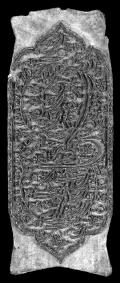

Indian Antique Textile
Stamp. Northern India, 19th century AD, or earlier. Antique textile
stamp, carved from a dense and heavy tropical wood, perhaps teak or
sandalwood. The block stamp roughly rectangular, with thick ridged handle.
Two ends are angled so that other stamps can be interlocked with it. The
raised, carved stamp design itself oblong with trefoil ends. The design
consists of Nastaliq script within intricate field of floral arabesques.
Size: 4 x 10". Block intact in very fine condition, with recent
export stamp on back.
Estimated Value $100-150.
Lot 855
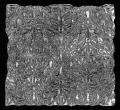

Indian Textile Stamp.
Northern India, 19th - early 20th century AD. Another similar textile
stamp, somewhat later, also carved from a dense and heavy tropical wood.
The block squarish, with ridged handle. The carved design is comprised of
two cruciform rosettes, each encompassed by floral arabesque borders
forming a hexagon shape. A quarter section of the same design appears at
each corner. Block very fine condition, the top of handle on the back an
old replacement. Size: 6-1/4 x 5-3/4". Attractive and decorative.
Object could still be used for art or craft projects.
Estimated Value
$100-150.
Lot 856
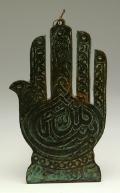

Persian Antique
Amuletic Hand Plaque. Iran. Cast and chased flat sheet shaped into a
stylized hand in an "open" position. The palm features a caligraphic
arabesque incorporating the name of Allah along with a band of script at
the wrist. The middle finger, the thickest of all the fingers is decorated
with an emblem of fish. The remaining fingers are patterned designs of
knotted floral arabesques. Hand with suspension loop for attaching to the
wall. Length: 7". The artifact shows some wear from being touched
constantly over the years, but is overall in fine condition, with brown and
green patina. A handsome objet d'art, showing the Moslem genius for
exploring the decorative possibilities of simple line and written text.
Estimated Value $200-300.
Lot 857
Persian Antique
Astrological Globe. Iran. The small copper globe sets on a tall base
consisting of two inscribed rings, attached by four columnar supports of
hexagonal section. The top ring is divided into four quadrants,
interspersed with text and marked with increments of degree. The base ring
appears similar, but a frieze of ornamental song birds and flowers replaces
the text. The globe is divided into fourteen zones of longitude, each with
inscriptions within. Likewise, two horizontal bands of text flank the
globe's equator. Height: 10 ¼". With variegated brown, green,
and red patina. A fascinating and decorative artifact of an age old
"science." Handsomely crafted, the globe makes a fine accent to one's
library, or other decor.
Estimated Value $500-750.
Lot 858


Persian Antique Bowl.
18th-19th century AD. Antique decorative bowl in tinned bronze. The
bowl, crafted in fine "bell" metal, is cast and turned featuring raised and
sunk concentric circular registers within and without. Exterior registers
display an s-shaped and hatched chiseled ornament. The interior is
decorated with foliate ornamentation along the sides while the base
displays a central rosette of five lobes, each with a flower within.
Diameter: 6''. With a variegated patina. Bowl is intact with some
wear to the tinning.
Estimated Value $250-350.
Lot 859
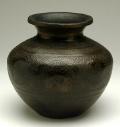

Persian Antique Bronze
Vase. Iran, 18th-19th century AD. Antique, decorative bronze vase of
handsome shape with elaborate chiseled decoration. The vase, wrought from a
cast blank features a thick and heavy mouth attached to the body of the
vessel in a heavy wrought sheet. The intricate chiseled ornamentation is
comprised of sinuous wave or gadroon-like floral borders, each framing a
standing peacock. Height: 5-3/4". With black-brown patina. Some
trivial dents, otherwise vessel well preserved.
Estimated Value
$300-400.
Lot 860
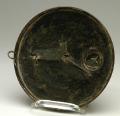

Persian Antique
Compass-Sextant. Iran. This interesting instrument of a circular
dish-like shape is fashioned from copper sheet. At center of face a flip up
gnomon appears in the form of a recumbent animal. Below is an adjustable
pointer, now frozen. The face of the dial is inscribed with a rectangular
grid surrounded by a band with directional arrows, and further, with a
circular band containing the signs of the zodiac. Towards outer edge is a
band of Arabic script. At side, a small compass inset. Back of object with
another directional grid. Diameter: 6-5/8". A fascinating bit of
ancient, traditional "technology."
Estimated Value $200-300.
Lot 861
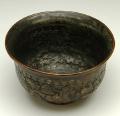

Persian Antique Copper
Bowl, with Engraved Scenes of the Hunt. Robust footed bowl of deep
shape with out-turned rim resembling an inverted bell. The exterior walls
are richly ornamented with repousee and engraved scene depicting a youthful
hunter on horse, chasing a pair of hinds. The horseman is repeated three
times amid changing scenery. Set in this frieze, a cartouche with Nastaliq
inscription. Above, an elaborate border of flowers and trefoils. Perhaps a
scene depicting Rustam, one of the legendary principles in the Shah-nameh.
Interior of bowl tinned, with traces of tinning on the exterior.
Width: 5-1/4"; Height: 3". An attractive objet
d'art.
The Shah-nameh, "Book of Kings", is the celebrated work of
the Persian epic poet Ferdowsi, in which the Persian national epic found
its final and enduring form. The Shah-nameh is a poem of nearly 60,000
verses, mainly based on the Khvatay-namak, a history of the kings of Persia
in Pahlavi (Middle Persian), from mythical times down to the 7th century.
Ferdowsi committed the various epic and literary traditions to verse, and
updated the story to the downfall of the Pre-Islamic Sasanid empire
(mid-7th century). For nearly 1,000 years this epic poem has remained one
of the most popular works in the Persian-speaking world. In addition, the
work has inspired and influenced a large repertoire of representational art
in Persia, and elsewhere in Asia, over the centuries.
Estimated Value
$300-400.
Lot 862


Persian Bronze
Incantation Bowl. Iran, circa 16th century AD. An interesting and well
crafted bowl of hammered and spun brass. The piece is incised throughout
with many lines of Persian script employing various amuletic prayers asking
God for a child. A most unusual ethnic heirloom. Diameter: 5-1/2".
With excellent dark green patina. In choice condition.
Estimated Value
$350-500.
Lot 863
Persian Bronze Mortar.
Seljuks, Iran, 12th-13th century AD. A heavy, substantial mortar in
bronze in an octagonal shape. The cylindric piece has a flaring shelf-like
rim and base. The mortar is richly ornamented with engraved floral
arabesques on the rim and base. The side panels are decorated with
alternating motifs of engraved vases with leaves, and a fowl or pea hen
within niche-like borders of floral arabesques. Height: 3-1/4";
Diameter: 4". Mortar intact and well preserved with attractive
verdigris patina.
Estimated Value $600-800.
Lot 864
Persian Bronze "Tea
Pot". Persian Luristan, circa 8th-7th century BC. A wonderful and
curious bronze vessel with long, protruding (open channeled) spout. This is
a metal version of this culture's distinctive ceramic vessels, featuring a
similar beak-like spout. The pot is a flattened conical shape, with ovoid
swelling to the throat of the spout. This surrounded by eleven decorative
bosses. Height: 4"; Length: 9". Excellent dark green patina,
with touches of red, and free from breaks and repairs.
Estimated Value
$500-750.
Lot 865


Persian Gaming Pieces.
Set of twenty Persian gaming pieces, dating to the mid-20th century.
These fibre plaques are lacquered and painted with the images of historical
Persian figures. Comprised of five different designs in suites of four, the
artwork on these charming counters clearly illustrates the influence of the
Oriental style. Each piece measures 1½ x 2¼". With minor flaws
inherent to medium. Still, in fine to very fine condition.
Estimated
Value $250-350.
Lot 866
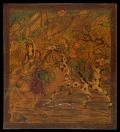

Persian Lacquer
Painting. Persian, circa 19th century. Lacquer painting on paperboard.
Indistinctly signed at the lower right in Persian. Measuring 15 x
16½". Corners are lightly worn, a few surface abrasions and chips,
and light crazing to varnish layer. In good to very good condition overall.
Outside city walls amid a stylized, forest-like setting, a youth
and warrior are seen engaged in a competition on horseback. A small herd of
animals appears to be watching the action, though two seem to be atop the
city wall. Interestingly, the symbolism presented here likely relates to
the mythology of the Shah-nameh.
The Shah-nameh, or "Book of Kings",
is the celebrated work of the Persian epic poet Ferdowsi, in which the
Persian national epic found its final and enduring form. The Shah-nameh is
a poem of nearly 60,000 verses, mainly based on the Khvatay-namak, a
history of the kings of Persia in Pahlavi (Middle Persian), from mythical
times down to the 7th century. Ferdowsi committed the various epic and
literary traditions to verse, and updated the story to the downfall of the
Pre-Islamic Sasanid empire (mid-7th century). For nearly 1,000 years this
epic poem has remained one of the most popular works in the
Persian-speaking world. In addition, the work has inspired and influenced a
large repertoire of representational art in Persia, and elsewhere in Asia,
over the centuries.
Estimated Value $500-750.
Lot 867
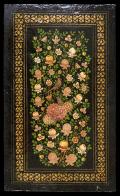

Persian Lacquer
Painting. Persian, circa 19th century. Lacquer painting on panel.
Measuring 7 x 11½". Framed to an overall size of 11¾ x
14½". A small abrasion to upper right corner, with a few inherent,
minor flaws. Still, in very fine condition.
Presented with delicate
skill, a pair of birds sits perched amid a bush, bountiful with blooming
flowers. These taupe hued birds blend easily into the rosy-peach flora. A
decorative gilt border frames the tranquil scene.
Estimated Value
$300-400.